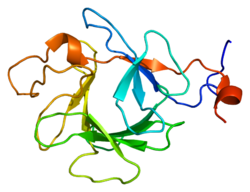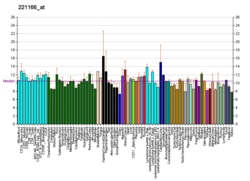Clinical significance
Mutations in FGF23, which render the protein resistant to proteolytic cleavage, lead to its increased activity and to renal phosphate loss, in the human disease autosomal dominant hypophosphatemic rickets.
FGF23 can also be overproduced by some types of tumors, such as the benign mesenchymal neoplasm phosphaturic mesenchymal tumor causing tumor-induced osteomalacia, a paraneoplastic syndrome. [15] [16]
Loss of FGF23 activity is thought to lead to increased phosphate levels and the clinical syndrome of familial tumor calcinosis. Mice lacking either FGF23 or the klotho enzyme age prematurely due to hyperphosphatemia. [17]
Over-expression of FGF23 has been associated with cardiovascular disease in chronic kidney disease including cardiomyocyte hypertrophy, vascular calcification, stroke, and endothelial dysfunction. [18]
FGF23 expression and cleavage is promoted by iron deficiency and inflammation. [19]
FGF23 is associated with at least 7 non-nutritional diseases of hypophosphatemia: aside from autosomal dominant hypophosphatemic rickets, X-linked hypophosphatemia, autosomal recessive hypophosphatemic rickets type 1, 2, and 3, Tumor-induced osteomalacia and Hypophosphatemic rickets with hypercalciuria. [18]
This page is based on this
Wikipedia article Text is available under the
CC BY-SA 4.0 license; additional terms may apply.
Images, videos and audio are available under their respective licenses.






